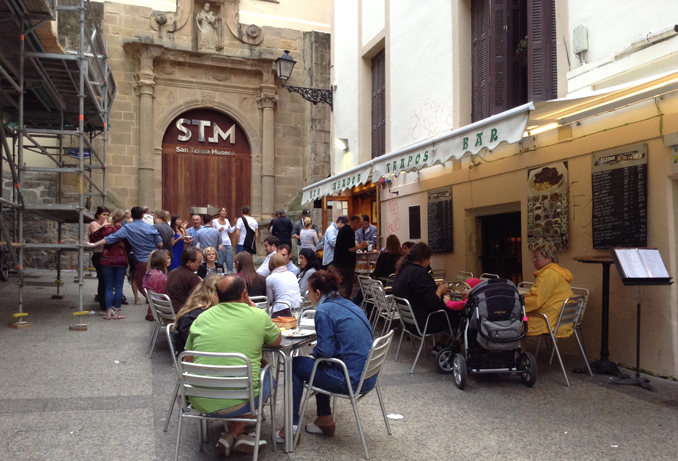Written by: Dr. Dushka H. Saiyid - Posted on: August 18, 2014 |  Comments | 中国 (Chinese)
Comments | 中国 (Chinese)
Google Translation: اُردو | 中文
Basque country lies in a pocket of territory to the north of Spain, between mountains and the Bay of Biscay. Their language, Euskara, is the oldest in Europe. Since they sided with the Republicans in the Spanish Civil War, a victorious Franco suppressed their language and culture. A nationalist resistance movement developed in response, which continued its bloody struggle for independence right up to 2011.
We took the bus to Bilbao from Pamplona (My first piece of the series was about Sanfermines and the running of the bulls). The Spanish coaches are clean, comfortable, punctual and relatively cheap. It was filled with young people leaving the Sanfermines, looking tired and still in their white clothes with red scarves round their necks. The flat plains were left behind as the bus began to climb through valleys and mist covered green mountains, reminiscent of Switzerland.
If Pamplona acquired international fame because of the fiesta of Sanfermines, the industrial city of Bilbao was put on the tourist map by the sensational architecture of the Guggenheim museum, when it opened in October 1997. Despite having seen many pictures of it, we were dazzled by the size and beauty of the Guggenheim: a splendid curving structure, shimmering in the mid-day sun, sheathed in 33000 titanium sheets that resemble the scales of fish. Frank Gehry’s innovative design had been inspired by his childhood fascination with fish, and the titanium had been harmoniously supplemented with the use of limestone and glass in creating this fluid looking structure.
Guarding the front of the building is Jeff Koons 12 m high sculpture of a Highland terrier called Puppy, and made up of thousands of Begonias, a perennial flowering plant. At the back of the museum is Louise Bourgeois’ sculpture of a giant spider, 30 ft high and 33 ft wide, called Maman. Bourgeois described Maman as an ode to her mother, whom she lost at the age of 21, and who managed the family business of tapestry restoration, and was clever and protective like a spider.
We wandered through the cavernous gallery, where amongst the temporary exhibits was the pop art of Yoko Ono, and a retrospective of Braque, a pioneer of cubism with Picasso.
 |
Eating pintxos in Parte Vieja or Old Town |
Having seen Bilbao’s main attraction, we left for the coastal city of San Sebastian the next day, just an hour’s drive by coach. The taxi dropped us outside Parte Vieja (Old Town), as vehicular traffic cannot enter its warren of narrow streets. Our hotel, like others in Parte Vieja, was on top of a pintxo (Basque version of tapas) bar and a shop. As the day advanced, the streets began to fill, and by nightfall the Old Town had become raucous. Known as the culinary capital of Spain, the pintxo bars are laden with a wide variety of bite-sized food piled in plates on the counter. The customers can help themselves to the variety on offer, or just focus on their preferences. Often people eat and drink standing on the streets, perching the food on the little tables attached to the walls of the pintxo bars; this might explain the lively street life in the Parte Vieja.
The four-mile ocean front promenade begins outside the Old City, and curves around the bay of Bahia de la Concha, ending in the Playa de la Concha beach. It is lined with restaurants and cafes, with fresh seafood on offer, and an aquarium and a naval museum for the more curious. During the daytime people sunned and swam on the pristine beach of Playa de Concha, while those into surfing had to go a little further to Playa de Gros. A short boat ride through the choppy waters of the Bay took us to Isla de Santa Clara, a small island that is a natural reserve.
San Sebastian is a good place to buy the Basque beret, which became a symbol of the French resistance in the II World War, and was Che Guevara’s signature headgear. They also had lovely hand made cosmetic jewelry and porcelain stuff.
Time was running out and we had to get back to Madrid to catch our flight out. We managed to squeeze in a flamenco performance (video on home page) in one of the small, more personal tablaos (restaurants where flamenco is performed) on our last night in Madrid. The flamenco dance form originated in Andalucia amongst the gitanos (Romani/Gypsum people of Spain). It consists of throaty singing, clapping of hands, playing of guitar and the dance. We sat in close proximity watching the dark eyed beauties stomp their feet and move dramatically to the soulful music. It was a befitting finale to a trip in which we had experienced just a small slice of Spain’s history and culture.
Click to view picture gallery